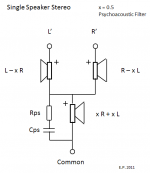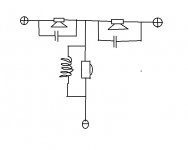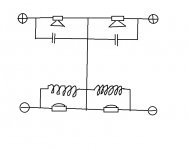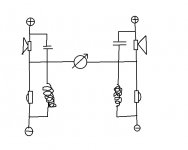Hello Elias,
Good work here. Can you please direct me to the exact wiring scheme that you used to implement the "0.5" attenuation.
There are some similarities here to the Haas effect to extract surround ambient signals using L-R or R-L and sent to surround speakers.
Here the schematic I use for SSS. Matrix x=0.5. And there is the psychoacoustic filter to steer the energy at high freqs.
Yes SSS increases the perception of 'surround' since for example left side element signal is:
L - 0.5*R = 0.5*( L + (L - R) )
which means there is the 'raw' left signal and 'surround' signal with equal amplitude.
- Elias
Attachments
Thanks Elias. What values are you using for the resistor and capacitor Rps and Cps. Thanks.
The component values are 'hidden' here:
Elias Pekonen Home Page - Stereophonic Sound from a Single Speaker
But the answer may depend, as usual. It can depend on the driver's high freq response, and the room.
Good starting point is to choose Rps as about half of the driver impedance. The Cps value can then be used to tune the corner frequency, and is best found either by measurements or listening tests.
For 8 ohm driver one can start with Rps = 4.7ohm and Cps = 4.7uF. But as said, it depends
- Elias
Hopefully your speakers have a flat resistive impedance curve.....................
Maybe 3 x fx120's.
I'd toss the cap and use a pot around the mono center speaker in post 381.
Keep your head the same distance to all 3 speakers and you'd have a winner.
I think I'll build something to test it.
A coffee table listener should work well.
Maybe 3 x fx120's.
I'd toss the cap and use a pot around the mono center speaker in post 381.
Keep your head the same distance to all 3 speakers and you'd have a winner.
I think I'll build something to test it.
A coffee table listener should work well.
Last edited:
I'd toss the cap and use a pot around the mono center speaker in post 381.
The capacitor may turn to be an essential part of the system.
It has the effect at high freqs of reducing the center element and boosting the side elements. This seems to be due to psychoacoustic requirements that the capacitor is to be used. It can be considered as energy steering of the stereo field.
And, at low freqs where the capacitor impedance is high the three elements work as a vector steering of the stereo field.
It is similar behaviour to Gerzon Ambisonics, which is based on low freq vector theory and high freq energy theory.
Now if you leave the capacitor out and use some resistor the frequency dependent nature of the function is no longer fullfilled.
- Elias
Hopefully your speakers have a flat resistive impedance curve.....................
Hehe... that's part of the reason why I tried it with bending wave devices. Their impedance curves are pretty flat (compared to most ordinary drivers).
Nevertheless, I think the problem of impedance curve would not be so great if the 3 drivers (with the loads) are identical. Paired drivers on hand are all measured very very close to each other.
If multi-way is used, then the problem would be mostly in the xover, I guess.
Any thoughts about this?
I think single mono tweeter leads to quite limited stereo presentation.
- Elias
The current version of the stereolith has a single tweeter.
If the old stereoliths worked like my second circuit the tweeters would have been mono with unsymmetric amps even then.
Yes Stereolith (TM) indeed has single tweeter, but since when has it been considered as ultimate ? I don't think single tweeter is any good, not for imaging and not for spaciousness. It is very simple to try out.
Also I don't know why Stereolith is like it is, maybe for cost reasons.
With version three one could test how much mono for the tweeters is tolerable.
For test purposes that may be a good idea, However I think the problem of single tweeter is not the mononess of the sound but the high spatial correlation of the single treble source which in my experience makes the source itself localisable.
I think it is better to use several tweeters (even for mono sound), or use some other methods of spatial decorrelation for example aiming the tweeters towards ceiling or side walls.
- Elias
- Home
- Loudspeakers
- Multi-Way
- Stereophonic Sound from a Single Loudspeaker




